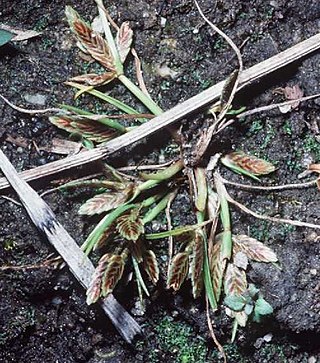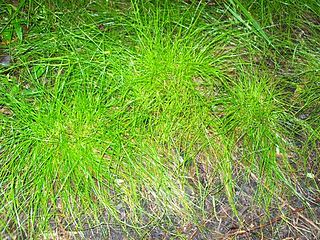
John Torrey was an American botanist, chemist, and physician. Throughout much of his career, he was a teacher of chemistry, often at multiple universities, while he also pursued botanical work, focusing on the flora of North America. His most renowned works include studies of the New York flora, the Mexican Boundary, the Pacific railroad surveys, and the uncompleted Flora of North America.

Cyperus is a large genus of about 700 species of sedges, distributed throughout all continents in both tropical and temperate regions.

Cyperus polystachyos, also known as Pycreus polystachyos, and also called manyspike flatsedge in the US, or bunchy sedge, coast flatsedge, many-spiked sedge or Texas sedge in Australia, is a herbaceous species in the family Cyperaceae, widespread in tropical and subtropical areas around the world, sometimes extending its range into temperate regions.

Cyperus eragrostis is a species of sedge known by several common names, including tall flatsedge, nutgrass, tall nutgrass, umbrella sedge, chufa, Earth almond, zula nuts, edible galingale and pale galingale.

Cyperus acuminatus is a common species of sedge known by several common names, including tapertip flatsedge and pale umbrella-sedge. This plant is native to North America, where it is widespread across the Great Plains and the western United States, with scattered populations in the eastern US as well as in Saskatchewan, Tamaulipas and Coahuila.

Cyperus bipartitus, commonly known as slender flatsedge, river cyperus, or the shining flatsedge, is a common species of sedge. The name "slender flatsedge" also applies to Cyperus gracilis.

Cyperus odoratus is a species of sedge known by the common names fragrant flatsedge and rusty flatsedge. This species is quite variable and may in fact be more than one species included under one name.

Cyperus laevigatus is a species of sedge known by the common name smooth flatsedge.

Cyperus gracilis, commonly known as slender flat sedge and slimjim flatsedge, is a species of sedge native to Australia. The species epithet gracilis refers to the graceful form of the leaves.

Cyperus trachysanthos is a rare species of sedge known by the common names pu`uka`a and sticky flatsedge. It is endemic to Hawaii, where it is known from Kauai and Oahu. It was known from Niihau, Molokai and Lanai, but it has been extirpated from these islands. It is a federally listed endangered species of the United States.
Cyperus fauriei is a rare species of sedge known by the common name alpine flatsedge. It is endemic to Hawaii, where it grows on the islands of Molokai and Hawaii. It is a federally listed endangered species of the United States.

Cyperus pennatiformis is a rare species of sedge known by the common name coastal flatsedge. It is endemic to Hawaii, where it grows on the islands of Maui, Kauai, and Laysan. It is a federally listed endangered species of the United States.

Cyperus grayoides is a species of sedge known as Illinois flatsedge and Mohlenbrock's umbrella sedge. It is endemic to the United States, where its distribution extends from Illinois through Missouri and Arkansas to Texas and Louisiana.
Umbrella flatsedge may refer to:
Cyperus cuspidatus, commonly known as the coastal plain flatsedge, is a sedge of the family Cyperaceae that is native to seasonally dry tropical areas of Africa, Asia, the Americas and Australia.

Cyperus javanicus, also known as the Javanese flatsedge, is a sedge of the family Cyperaceae that is native to Indonesia and Australia.

Cyperus retrorsus, commonly called pine barren flatsedge, is a species of flowering plant in the sedge family (Cyperaceae). It is found primarily in the Southeastern United States, with a range extending north to Martha's Vineyard, Massachusetts and south to Tamaulipas, Mexico. Its natural habitat corresponds to dry sandy soils, open woodlands and thickets.
Cyperus setigerus is a species of sedge that is native to central and southern parts of the United States, recorded from Kansas, Oklahoma, Texas, Missouri, and New Mexico.














